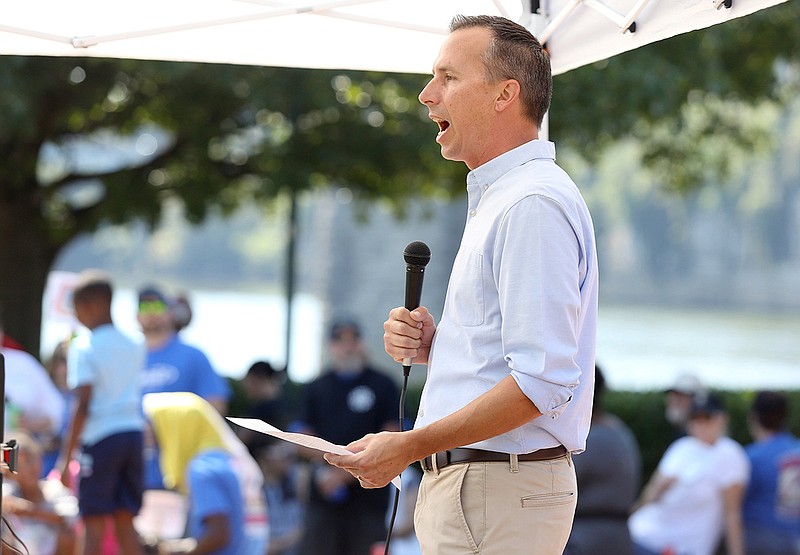The first step in solving any problem is to acknowledge one actually exists.
If the Hamilton County public schools landscape — academics and extracurricular activities, including athletics — is ever going to improve, it's time to start being honest: The county simply has too many schools.
Add up the cost of everything lacking — facilities are outdated, coaching staffs are shorthanded and academics also lag behind by comparison — and it's clear that for a county the size of Hamilton, there isn't enough revenue generated to meet the needs.
In short, having too many schools has caused the money for upkeep to be spread too thin for far too long, and the result is a $1.36 billion deficit in deferred maintenance, plus athletic facilities that are severely outdated.
On the athletic side, Hamilton County has become woefully incapable of competing — particularly in the TSSAA's revenue-producing sports, football and basketball — at the state level.
Over the past decade, Hamilton County's 13 high school football teams have lost 62% of the 680 games they played against opponents from outside the county. By comparison, the nine public schools in smaller Rutherford County have won 65% of the 577 games they played against teams from outside their county during the same time frame.
Red Bank and Tyner have been by far the most successful Hamilton County football programs recently, accounting for 17 of the 23 playoff wins by county teams over the past five seasons, with all other public schools in the county combining for a 6-34 playoff record in those years. Last season, Red Bank was the only county team of eight that qualified to get past the first round.
One local football coach said when his team plays on the road, the comparison of facilities and coaching staff sizes (Hamilton County allows for four paid assistants, while many programs outside the county can have 12 to 15 on their staff) is eye-opening. He admitted "it's like being the poor kid who doesn't realize they're poor until they go to a friend's house and see how much nicer things are."
But it isn't just the state's elite programs that have left Hamilton County public schools in their wake. Anderson County played in the same football region as five Hamilton County teams (Central, East Hamilton, East Ridge, Hixson and Howard) from 2017-20. None of those Mavericks teams got past the quarterfinal round of the playoffs, but during that time they outscored Chattanooga opponents by an average of 46-8.
The numbers are even worse in basketball, where Brainerd produced the county's most recent state champion in both the boys' (1992) and girls' (1984) brackets. Over the past decade, local boys' teams have gone 5-16 at the state tournament, while only two girls' teams (Lookout Valley in 2000 and Arts & Sciences in 2010) have even advanced to the eight-team state tourney in the past 21 seasons.
Among the TSSAA's nonrevenue sports — which include bowling, cross country, golf, soccer, tennis, track, volleyball and wrestling — Signal Mountain teams have carried the postseason torch for the county, winning 25 state titles in the school's 14 years of existence. The county's other 18 high schools that compete in TSSAA sports have combined for six state championships over the same time frame.
With around 20,000 fewer residents, Rutherford is closest to Hamilton in population among Tennessee counties. However, Rutherford has 12 fewer public schools, eight of which compete in the TSSAA's largest classification, while Hamilton County is the only one among the state's top 13 in population that does not have a football team competing in the largest class.
That's because Chattanooga has long been unique in that it is made up of so many smaller communities. And each one — Brainerd, East Ridge, Harrison (home of Central High School), Hixson, Howard, Ooltewah, Red Bank, Sale Creek, Signal Mountain, Soddy-Daisy and Tyner — is staunchly proud of its school.
What originally made those schools special was the pride shown through sweat equity and funding from community members for upkeep. Now there are mostly just words of support rather than action.
Fewer families have disposable income or free time, so while there's a level of nostalgia for those who attended the community schools, they aren't backing it up with their checkbooks. In 2019, a proposed 34-cent property tax rate increase that would have boosted the county's operating budget for the first time in 14 years was voted down by county commissioners.
"Our schools are falling apart, and it's going to cost money to fix it," said David Sharpe, commissioner for District 6. "We have to do better for our kids. To pay for those things, basic math tells you those services and facilities come at a cost, and if we don't have the money, it will require new revenue from somewhere."
So Hamilton County is at a crossroads when it comes to deciding where its priorities lie.
There appear to be only three choices. Would investigating a possible 1-cent or half-cent SPLOST tax, which could be used as it is in northwest Georgia specifically for educational improvement projects, be the answer? Or has it reached a critical enough stage that a property or wheel tax increase would now be accepted?
If county residents aren't ready to help fund educational improvements, the only remaining solution would be scuttling several schools so the money that is on hand isn't spread so thin.
Contact Stephen Hargis at shargis@timesfreepress.com or 423-757-6293. Follow him on Twitter @StephenHargis.
